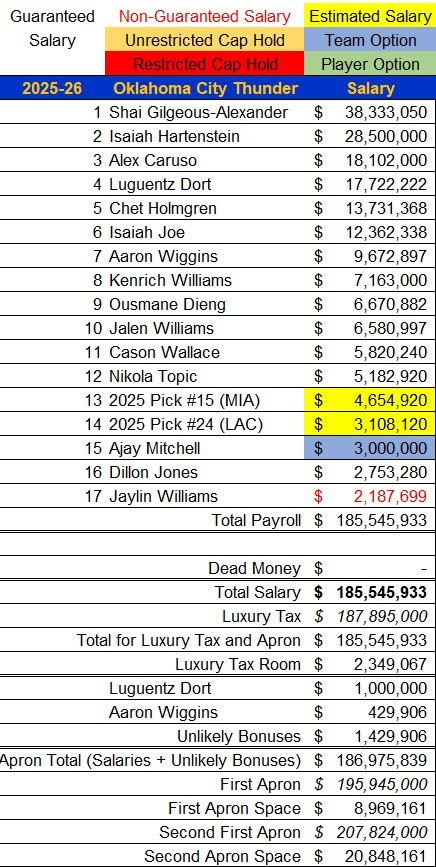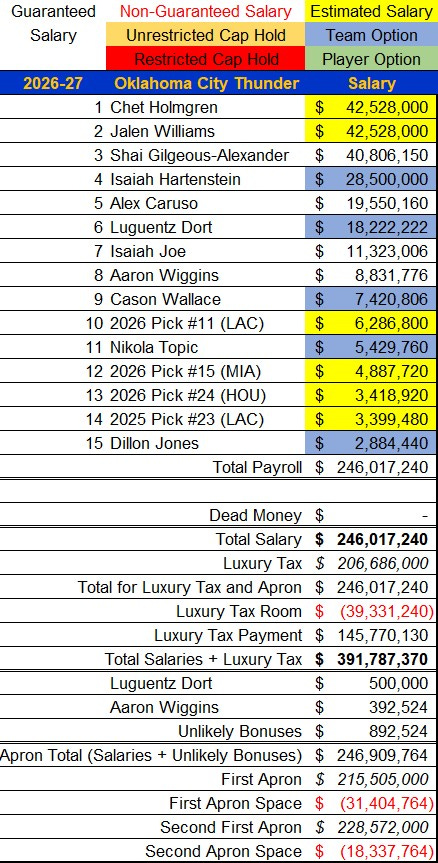How the League Let the Oklahoma City Thunder Become a Potential Dynasty + Projecting the Rest of their Window
I examine how the Thunder benefited from fundamental changes to the league and project how far they could extend this window.
12 years ago, the Philadelphia 76ers hired a man named Sam Hinkie as general manager. He commenced a years-long process that involved aggressively losing to maximize their lottery odds. He was a polarizing figure who arguably had the second greatest impact on the NBA in the 2010s after Stephen Curry.
The implications of this forced the league to vote on modifying the lottery odds just one year into the process. They wanted to flatten the odds and make them closer to the system we have today to dissuade teams from tanking. It didn’t get enough support at the time, but it eventually passed and went into effect for the 2019 draft.
One of the biggest opponents of lottery reform is Oklahoma City Thunder general manager Sam Presti. He fought against it every time it was voted on along the way. He argued that the lottery was the only chance for small-market teams to get superstars, and that lottery reform was minimizing their chances at that.
He might tell you today that it isn’t necessarily true. The Thunder went through a “process” of their own, but a much shorter one consisting primarily of two losing seasons in 2021 and 2022. Yes, he got one of his stars by lucking into the second overall pick in the 2022 NBA Draft. But he got another one 10 spots later. He also acquired an MVP in a trade who was also selected outside of the top 10 in his draft.
But while the “process” itself was the blueprint to constructing a talented young core, it’s the impact it had on the league and teams for years to come that put the Thunder in a position to dominate the rest of the decade.
Lottery reform hasn’t dissuaded teams from tanking, but it has mostly curbed the extremes teams used to go to. Probably more effective, the league also implemented the Play-In Tournament in 2020, which has given many teams in the middle more chances at making the playoffs.
But the most significant impact of the league’s attempts to add more parity in the league is giving more teams the belief that they have a chance. And no better spark to motivate teams to compete than the end of the Warriors dynasty coinciding with lottery reform.
The Lakers were the first to trade multiple first-round picks and young players for Anthony Davis. The Thunder, who lost in the first round for a second consecutive season, realized they weren’t going anywhere and saw an opportunity to cash in on their stars. So they traded Paul George to the Clippers for five first-round picks, one of which became Jalen Williams. They also got a young Shai Gilgeous-Alexander.
This is brought up not to relitigate the George trade. This trade was just the start of a process that would have the Thunder aggressively trade their veterans to increase their surplus of first-round picks.
They followed up the George trade by trading franchise player Russell Westbrook for two first-round picks and two pick swaps. They also traded Jerami Grant for one first-round pick. They went on to make the playoffs in 2020 and almost win a first-round series led by Chris Paul, who many assumed would’ve been traded before then.
The 2020-21 season is where they got most of their trades done. They added 3 first-round picks for Dennis Schroder, Chris Paul, and swapped Danny Green for Al Horford. They also added 12 second-round picks. They continued their asset accumulation into 2021-22 but with diminishing returns. By then, they were ultra-focused on drafting and development.
While most of the league went all-in on the present, the Thunder were among the only teams heavily investing in their future. The league zigged toward competing in the present at any cost, and the Thunder zagged hard.
Now they have a deep roster with 11 extra first-round picks over the next eight drafts to sustain it. This is what will let them navigate the new CBA, its aprons, and sustain a long run through the end of the decade.
This is significant because the Thunder seem unlikely to make any moves that impact their roster this season. Just about every other team in the league will need to do something to at least address their rotation. The Thunder might just sit back and run it back with at least 85 percent of the 2024-25 roster.
So, instead of analyzing their salary cap dynamics for the upcoming offseason, the rest of this post will analyze how they could extend this window through the end of the decade.

The Thunder are entering the offseason with 17 players under contract, including the 15th and 24th overall selections in the 2025 draft. They will need to cut down to 15 before the start of the season. Look for them to get off one of those draft picks and one player who doesn’t project to be in their plans, like Ousmane Dieng.
For example, trading Dieng and the 24th selection for a future first-round pick would get the Thunder down to 15 players. It would also save them approximately $10 million against the luxury tax. That would give them room to add another rotation player, but more likely, take on bad salaries with more draft picks to add onto the pile.
The Thunder have 11 first-round and 17 second-round picks through 2032. Many have speculated over the years if they’ll ever cash those in for an All-NBA player like Giannis Antetokounmpo. They seem unlikely to be even remotely interested in pursuing such a trade after winning a championship with their group. Instead, look for the Thunder to keep these picks and add more to help further extend the window.
The new harsher luxury tax system and second apron penalties have stifled the 2023 champion Nuggets and likely force the 2024 champion Celtics to retrench their payroll. Will this Thunder team face the same fate a couple of years from now?
Short term, no.
Chet Holmgren and Jalen Williams will be extension-eligible this summer and are both expected to receive maximum contracts. They are projected at $246.7 million over five years and would start at $42.5 million. They could receive up to the 30 percent maximum amount if they meet the higher maximum criteria, such as making an All-NBA team. Expect the Thunder to negotiate escalators depending on which All-NBA team they make.
Let’s assume both get the 25 percent maximum contract. The Thunder would project to have a roster exceeding $390 million in 2026-27 when factoring in estimates for all their 2025 and 2026 first-round picks. They’d be $18 million above the second apron with a $146 million tax penalty.
Gilgeous-Alexander will also be extension-eligible this summer for up to four years, $293.4 million. It would start him at $65.5 million, but unlike Williams and Holmgren’s deals, this extension wouldn’t start until 2027-28.
It should be noted that while Presti rightfully receives credit for many things leading up to this moment, he never receives any credit for the way he handled negotiations on Shai Gilgeous-Alexander’s current contract. He signed him to a maximum extension, but made sure not to give him a player option in what would be the 2026-27 season.
This is the most underappreciated decision to come out of the Thunder’s front office in the past six years. Gilgeous-Alexander is set to make $40.8 million in 2026-27. If he had a player option, he would likely decline it to extend for a five-year, $345.3 million supermax. This would boost his salary up to $59.5 million for 2026-27, which would increase that $146 million tax penalty up to $275 million, and total roster expenses close to $550 million.
The Thunder will become taxpayers as early as 2026-27. The big question is, will they draw a line somewhere? They may be willing to write a blank check on this roster if they repeat in 2025-26 based on their spending history.
The Thunder have shown a willingness to spend despite being one of the smallest market teams. They’ve been taxpayers five times between 2014-15 and 2019-20, including a $61.6 million payment in 2018-19. That was one of the highest tax penalties in the history of the league at the time.
If there are changes to be made, it will start at the bottom. Players like Isaiah Joe and Aaron Wiggins, as great as they’ve been on the contract they’re on, are expendable. The Thunder could seek their replacements in the upcomings two drafts so they could trade them later.
Alex Caruso was recently extended to a four-year, $81.1 million extension. They wouldn’t have reached the Finals without him, but will he remain at this level as he enters his early 30s? The Thunder could look to move him in a couple of years so they could fit Cason Wallace’s next contract.
Isaiah Hartenstein and Lu Dort have team options for 2026-27. This isn’t to suggest the Thunder would decline them and let them go to save money, but they could restructure them to new contracts. Perhaps both players could accept contracts with lower annual salaries than they currently make to help extend this window further.
And again, this is what the extra draft picks are for. There’s a possibility they continue to find talent, which makes the decision to part with some of the role players mentioned an easier decision to make. But to simplify things, the Thunder have a long way to go before they’re in a position to even consider moving any of Gilgeous-Alexander, Williams, or Holmgren.
The Thunder may want to at least avoid the second apron in 2026-27. That would give them a two-year window in 2027-28 and 2028-29 to go deep into the second apron and spend as much as possible. That would lead to a four-year window with this core between 2026-27 and 2028-29.
After that, things maybe could change significantly. The Thunder will have already entered the repeater tax, leading to substantially higher tax rates. They’ll also have seen their 2035 and 2036 first-round picks frozen. One more year in the second apron and they’ll have the 2035 first-round pick fall to the end of the first round.
But could the Thunder dare to continue spending and accumulating future draft pick penalties beyond that score? The Thunder have so many draft picks that they might be immune to the future penalties of the second apron. Their demise seems more likely to come from their players declining or their top players wanting to play elsewhere.
So long term, no. As long as the Thunder play at an elite level and keep the good vibes rolling, they should continue this window through the end of the decade.
You can also see me on:
CapSheets.com to view all my salary cap data,
Twitter and BlueSky for instant transaction analysis,
and YouTube for more cap analysis and conversations with guests!





